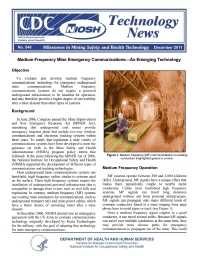Mining Publication: Technology News 546 - Medium Frequency Mine Emergency Communications—An Emerging Technology
Original creation date: February 2012
To evaluate' and develop medium frequency communications technology for emergency underground mine communications. Medium frequency communications systems do not require a powered underground infrastructure to be installed for operation, and may therefore provide a higher degree of survivability after a mine disaster than other types of systems. In June 2006, Congress passed the Mine Improvement and New Emergency Response Act (MINER Act), mandating that underground coal mines provide emergency response plans that include two-way wireless communications and electronic tracking systems within three years. To satisfy that legislation a wide variety of communications systems have been developed to meet the guidance set forth in the Mine Safety and Health Administration (MSHA) program policy letters that followed. In the years following the MINER Act of 2006, the National Institute for Occupational Safety and Health (NIOSH) supported the development of different types of communications and tracking technologies. Most underground mine communications systems use hand-held, high frequency radios similar to systems used on the surface. These high frequency systems require the installation of underground powered infrastructure that is susceptible to damage from events such as roof falls and explosions. In contrast, medium frequency (MF) systems use existing mine conductors for communications, such as underground transport rails and mine power cables, which have a better chance of remaining intact after a mine disaster. In December 2006, NIOSH entered into an interagency agreement with the US Army to evaluate communications technology originally developed by Kutta Technologies for the military, with the goal of adapting that technology for mine emergency communications.
Authors: NW Damiano
Technology News - February 2012
NIOSHTIC2 Number: 20040120
Pittsburgh, PA: U.S. Department of Health and Human Services, Public Health Service, Centers for Disease Control and Prevention, National Institute for Occupational Safety and Health, DHHS (NIOSH) Publication No. 2012-110, TN 546, 2011 Dec; :1-2
See Also
- Application of Extreme Power Line Communication Methods to Mine Environments
- Development of a Method for the Remote Characterization of Underground Mine Ventilation Control by Multiple Tracer Gases
- Emergency Communications and Tracking
- Fire Response Preparedness for Underground Mines
- Passive Fiber Optic System for Locating, Tracking, and Communicating with Personnel in Coal Mines
- Performance and Safety Investigation of Emergency Backup Batteries and Battery Charging Systems for Underground Mining Applications
- Recommendations for Refuge Chamber Operations Training
- Refuge Alternatives in Underground Coal Mines
- Safe and Economical Inerting of Sealed Mine Areas
- Ultra-Low Frequency Through-the-Earth Communication Technology
- Wireless Mesh Mine Communication System
- Content source: National Institute for Occupational Safety and Health, Mining Program


 ShareCompartir
ShareCompartir
